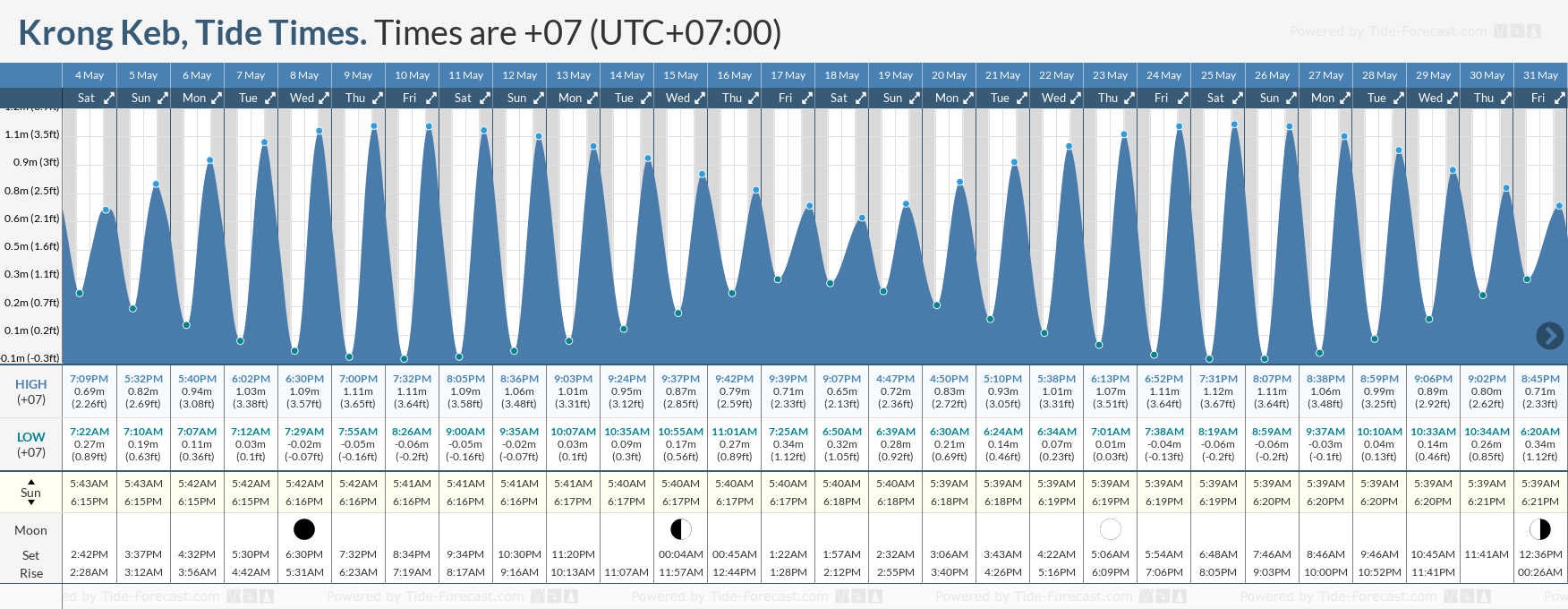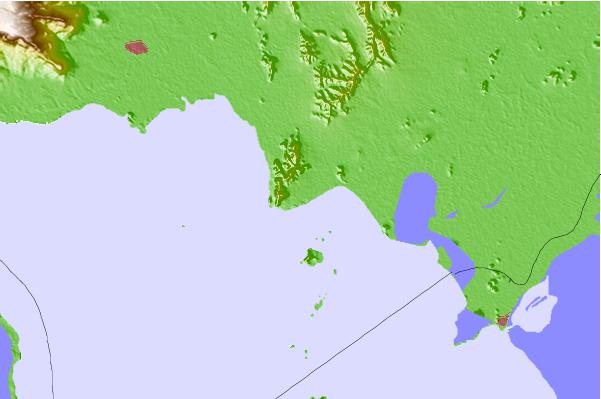Krong Keb: Coastal Bliss And Cultural Heritage
Are you planning a trip to Krong Keb? Don't forget to check the tide times and the tide chart before hitting the beach! Here's all you need to know about the tides in Krong Keb:

Krong Keb is a stunning coastal city located in Cambodia, known for its picturesque beaches and crystal-clear waters. Whether you're a sunbather, surfer or simply looking to go for a refreshing swim, you'll find that Krong Keb has something to offer for everyone. However, it's essential to keep in mind that the tide can significantly impact your time spent by the beach.
When it comes to tides, Krong Keb experiences semi-diurnal tides, meaning that there are two high tides and two low tides every day. The time and height of each tide can vary from day to day due to the gravitational pull of the moon and the sun. Therefore, it's always recommended to check the tide times and the tide chart for Krong Keb before planning your beach activities.
The tide times are the times when the tide reaches a specific height, and the tide chart shows the predicted tide height for a specific day. High tides are ideal for activities such as swimming and surfing, while low tides can be perfect for exploring tide pools, collecting seashells, and even walking along the beach. However, it's essential to keep in mind that during low tides, some parts of the beach may be exposed, making it hard to swim.
If you're planning on visiting any of Krong Keb's beaches, you'll find that most of them are stunning and offer plenty of activities. For instance, Lonely Beach is the perfect destination if you're looking for a relaxing and peaceful beach with crystal-clear waters. Other famous beaches in Krong Keb include Ream Beach and Otres Beach, both of which are perfect for swimming and sunbathing.
Apart from its beaches, Krong Keb is also home to many cultural landmarks that are worth exploring. The city boasts of an array of ancient temples, historical museums, and local markets where you can immerse yourself in the local culture. Among the notable landmarks are the Wat Preah Prom Rath, the Ream National Park, and the Kbal Chhay Waterfalls.
Demographics and Culture
Krong Keb boasts of a rich and diverse culture that is greatly influenced by its people's beliefs, traditions, and customs. The majority of Krong Keb's population are Khmer, who make up 90% of the total population. Other ethnic groups include the Chinese, Vietnamese, and Cham.
The people of Krong Keb are highly religious and are predominantly followers of Theravada Buddhism. Therefore, you'll find many temples and pagodas scattered throughout the city, all of which boast of stunning architecture and religious significance.
Tourist Destinations
Apart from its beaches and cultural landmarks, Krong Keb has various tourist destinations worth visiting. One such destination is the Bokor Hill Station, located at 1,080 meters above sea level. This attraction is a French-built hill station that dates back to the early 1920s and offers incredible views of the city and the surrounding countryside.
Another popular tourist destination in Krong Keb is the Koh Rong Island, which is located about 25 km south of the city. This island is home to some of the most stunning beaches in Cambodia, and visitors can indulge in various activities such as diving, snorkeling, and swimming.
Shopping and Culinary
When it comes to shopping and culinary experiences, Krong Keb has plenty to offer. The city boasts of local markets, where you'll find a variety of handmade crafts, textiles, and souvenirs. You'll also find various stores selling clothes, electronics, and other items.
Krong Keb also has a vibrant culinary scene, influenced by the local Khmer cuisine, Chinese cuisine, and even Vietnamese cuisine. Some of the must-try dishes include the Fish Amok, Khmer red curry, and the famous Kampot pepper crab. You'll find many restaurants and food stalls serving these delicacies throughout the city.
Tips
If you're planning on visiting Krong Keb, here are some tips to keep in mind:
- Check the tide times and the tide chart before planning your beach activities to ensure that you're not caught off guard.
- Carry plenty of sunscreen, as the sun can get pretty hot in Krong Keb, even during the winter months.
- Ensure that you dress appropriately when visiting religious sites such as temples and pagodas. This means covering your shoulders and knees.
- Adhere to local customs and traditions, especially in regards to public displays of affection and clothing.
FAQ
Here are some frequently asked questions about Krong Keb:
What is the best time to visit Krong Keb?
The best time to visit Krong Keb is during the dry season, which runs from November to May. During this period, the weather is dry and sunny, making it ideal for beach activities and outdoor adventures. However, it's worth noting that this is also the peak tourist season, so expect crowds and higher prices.
How do I get to Krong Keb?
You can get to Krong Keb by air, train, or bus. The city is served by the Sihanoukville International Airport, which receives direct flights from various international destinations. Alternatively, you can take a train or a bus from Phnom Penh, the capital city of Cambodia, or other neighboring cities.
What currency is used in Krong Keb?
The currency used in Krong Keb is the Cambodian Riel (KHR), although the US Dollar is widely accepted in most tourist areas.
What are the famous beaches in Krong Keb?
Krong Keb is home to many stunning beaches, with some of the most famous ones being Lonely Beach, Ream Beach, and Otres Beach.
What are the must-try dishes in Krong Keb?
Some of the must-try dishes in Krong Keb include the Fish Amok, Khmer red curry, and the famous Kampot pepper crab.
Now that you know everything about Krong Keb, it's time to pack your bags and head to this beautiful coastal city. With its stunning beaches, vibrant culture, and delicious cuisine, you're sure to have an unforgettable experience. Don't forget to check the tide times and the tide chart before you head to the beach, so you don't miss out on all the fun!


Post a Comment for "Krong Keb: Coastal Bliss And Cultural Heritage"